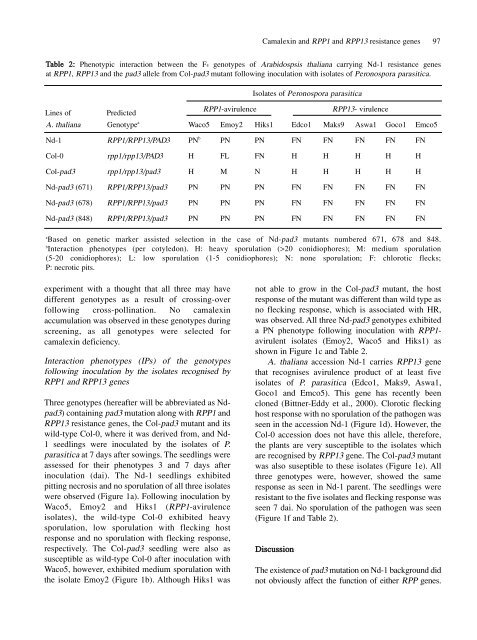Full Journal - Journal of Cell and Molecular Biology - Haliç Üniversitesi
Full Journal - Journal of Cell and Molecular Biology - Haliç Üniversitesi
Full Journal - Journal of Cell and Molecular Biology - Haliç Üniversitesi
You also want an ePaper? Increase the reach of your titles
YUMPU automatically turns print PDFs into web optimized ePapers that Google loves.
Table 2: Phenotypic interaction between the F4 genotypes <strong>of</strong> Arabidospsis thaliana carrying Nd-1 resistance genes<br />
at RPP1, RPP13 <strong>and</strong> the pad3 allele from Col-pad3 mutant following inoculation with isolates <strong>of</strong> Peronospora parasitica.<br />
Lines <strong>of</strong> Predicted<br />
A. thaliana Genotype a<br />
Nd-1 RPP1/RPP13/PAD3 PN b<br />
experiment with a thought that all three may have<br />
different genotypes as a result <strong>of</strong> crossing-over<br />
following cross-pollination. No camalexin<br />
accumulation was observed in these genotypes during<br />
screening, as all genotypes were selected for<br />
camalexin deficiency.<br />
Interaction phenotypes (IPs) <strong>of</strong> the genotypes<br />
following inoculation by the isolates recognised by<br />
RPP1 <strong>and</strong> RPP13 genes<br />
Three genotypes (hereafter will be abbreviated as Ndpad3)<br />
containing pad3 mutation along with RPP1 <strong>and</strong><br />
RPP13 resistance genes, the Col-pad3 mutant <strong>and</strong> its<br />
wild-type Col-0, where it was derived from, <strong>and</strong> Nd-<br />
1 seedlings were inoculated by the isolates <strong>of</strong> P.<br />
parasitica at 7 days after sowings. The seedlings were<br />
assessed for their phenotypes 3 <strong>and</strong> 7 days after<br />
inoculation (dai). The Nd-1 seedlings exhibited<br />
pitting necrosis <strong>and</strong> no sporulation <strong>of</strong> all three isolates<br />
were observed (Figure 1a). Following inoculation by<br />
Waco5, Emoy2 <strong>and</strong> Hiks1 (RPP1-avirulence<br />
isolates), the wild-type Col-0 exhibited heavy<br />
sporulation, low sporulation with flecking host<br />
response <strong>and</strong> no sporulation with flecking response,<br />
respectively. The Col-pad3 seedling were also as<br />
susceptible as wild-type Col-0 after inoculation with<br />
Waco5, however, exhibited medium sporulation with<br />
the isolate Emoy2 (Figure 1b). Although Hiks1 was<br />
Camalexin <strong>and</strong> RPP1 <strong>and</strong> RPP13 resistance genes 97<br />
Isolates <strong>of</strong> Peronospora parasitica<br />
RPP1-avirulence RPP13- virulence<br />
Waco5 Emoy2 Hiks1 Edco1 Maks9 Aswa1 Goco1 Emco5<br />
PN PN FN FN FN FN FN<br />
Col-0 rpp1/rpp13/PAD3 H FL FN H H H H H<br />
Col-pad3 rpp1/rpp13/pad3 H M N H H H H H<br />
Nd-pad3 (671) RPP1/RPP13/pad3 PN PN PN FN FN FN FN FN<br />
Nd-pad3 (678) RPP1/RPP13/pad3 PN PN PN FN FN FN FN FN<br />
Nd-pad3 (848) RPP1/RPP13/pad3 PN PN PN FN FN FN FN FN<br />
a Based on genetic marker assisted selection in the case <strong>of</strong> Nd-pad3 mutants numbered 671, 678 <strong>and</strong> 848.<br />
b Interaction phenotypes (per cotyledon). H: heavy sporulation (>20 conidiophores); M: medium sporulation<br />
(5-20 conidiophores); L: low sporulation (1-5 conidiophores); N: none sporulation; F: chlorotic flecks;<br />
P: necrotic pits.<br />
not able to grow in the Col-pad3 mutant, the host<br />
response <strong>of</strong> the mutant was different than wild type as<br />
no flecking response, which is associated with HR,<br />
was observed. All three Nd-pad3 genotypes exhibited<br />
a PN phenotype following inoculation with RPP1avirulent<br />
isolates (Emoy2, Waco5 <strong>and</strong> Hiks1) as<br />
shown in Figure 1c <strong>and</strong> Table 2.<br />
A. thaliana accession Nd-1 carries RPP13 gene<br />
that recognises avirulence product <strong>of</strong> at least five<br />
isolates <strong>of</strong> P. parasitica (Edco1, Maks9, Aswa1,<br />
Goco1 <strong>and</strong> Emco5). This gene has recently been<br />
cloned (Bittner-Eddy et al., 2000). Clorotic flecking<br />
host response with no sporulation <strong>of</strong> the pathogen was<br />
seen in the accession Nd-1 (Figure 1d). However, the<br />
Col-0 accession does not have this allele, therefore,<br />
the plants are very susceptible to the isolates which<br />
are recognised by RPP13 gene. The Col-pad3 mutant<br />
was also suseptible to these isolates (Figure 1e). All<br />
three genotypes were, however, showed the same<br />
response as seen in Nd-1 parent. The seedlings were<br />
resistant to the five isolates <strong>and</strong> flecking response was<br />
seen 7 dai. No sporulation <strong>of</strong> the pathogen was seen<br />
(Figure 1f <strong>and</strong> Table 2).<br />
Discussion<br />
The existence <strong>of</strong> pad3 mutation on Nd-1 background did<br />
not obviously affect the function <strong>of</strong> either RPP genes.

















